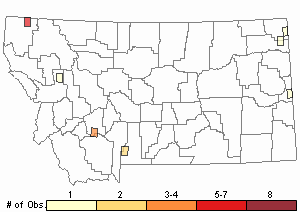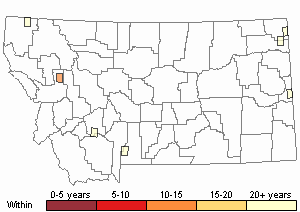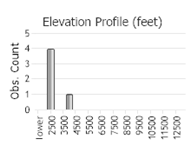View in other NatureServe Network Field Guides
NatureServe
Montana
Utah
Wyoming
Idaho
Wisconsin
British Columbia
South Carolina
Yukon
California
New York
Nevada Clubrush - Amphiscirpus nevadensis
Other Names:
Nevada Bulrush,
Scirpus nevadensis
State Rank Reason (see State Rank above)
Amphiscirpus nevadensis is known from four counties in western Montana and two counties in eastern Montana. Plants grow only in alkaline, seasonally wet places. Plants may be locally common, but across Montana's wetlands are uncommon. Although wetland habitat is more limited and often subjected to anthropogenic disturbances, specific threats have not been identified. Current data on population sizes, threats, and habitat requirements along with better mapping of occurrences is greatly needed.
- Details on Status Ranking and Review
Range Extent
ScoreG - 200,000-2,500,000 sq km (~80,000-1,000,000 sq mi)
Comment223,344 square kilometers.
Area of Occupancy
ScoreD - 6-25 4-km2 grid cells
CommentMontana can be divided into 30,390 4x4 square kilometer cells. For this species plant observations occur in 10 of these 4x4 square kilometer cells.
Number of Populations
ScoreB - 6 - 20
Comment18 observations represent 13 unique locations.
Number of Occurrences or Percent Area with Good Viability / Ecological Integrity
ScoreC - Few (4-12) occurrences with excellent or good viability or ecological integrity
Comment5 assumed of 'good viability' based on descriptors of 'monoculture-dominant' and 'common'.
Environmental Specificity
ScoreB - Narrow. Specialist or community with key requirements common
CommentAlkaline wetlands.
Threats
ScoreU - Unknown
CommentIn general wetland habitats have a greater chance of being threatened than terrestrial habitats in Montana. Specific threats are unknown.
General Description
PLANTS: Perennial plants with erect, wiry, round (terete) stems of 10-40(50) cm tall and creeping rhizomes. Sources: Lesica et al. 2012; Giblin et al. [eds.] 2018.
LEAVES: Clustered at the base and lower stem. Leaf blades inrolled and narrow (0.5-2.0 mm wide). Lower-most leaves disintegrate into fibers. Ligules are noticeably ciliate. Sources: Lesica et al. 2012; Giblin et al. [eds.] 2018.
INFLORESCENCE: 1-6 sessile spikelets in a head-like cluster (capitate), terminal or nearly so on the stem, and subtended by 1 leaf-like bract and 1-2 scale-like bracts. Spikelets are 6-12(20) mm long. Leaf-like bract is 1.5-7 mm long. Sources: Lesica et al. 2012; Giblin et al. [eds.] 2018.
Amphiscirpus has been separated from Scirpus. In Greek amphi means 'doubtful' or 'ambiguous' and scirpus means 'bulrush' (Smith in Flora of North America [FNA] 2002).
Phenology
Fruiting in summer (Smith in FNA 2002).
Diagnostic Characteristics
Amphiscirpus is separated from
Scirpus and
Schoenoplectus mostly on the basis of stem (culm) anatomy (Smith
in FNA 2002).
Amphiscirpus lacks internal cell cavities and leaves have obvious ciliate ligules (Smith
in FNA 2002).
Nevada Clubrush -
Amphiscirpus nevadensis, Native, SOC
*Perianth Bristles: 1-6, inconspicuous and shorter than the achene.
*Achene: Not tipped with a beak; style absent. Subtended by a scale.
*Scales: Awn absent.
*Spikelets: Solitary, but usually some plants have at least 2 spikelets; 6-12 mm long. Always with 1 long, leaf-like bract below (subtended) the spikelets.
*Stems: Round, wiry, and erect. Lacks internal cavities.
*Leaves: Basal and on lower stem, 0.5-2.0 mm wide.
*Habitat: Moist to wet alkaline wetlands, but not aquatic.
Bulrushes -
Schoenoplectus and
Scirpus, Natives
*Achene: Tipped with a beak (style). Subtended by a scale.
*Spikelets: Most species have 2 to many spikelets on stems (peduncles);
Schoenoplectus pungens has sessile spikelets;
Schoenoplectus subterminalis has a solitary spikelet. Subtending the spikelets are 2 or more leaf-like bracts.
*Stems: Internal cavities present.
*Leaves: Absent or leaves present (lower stem or basal)
and ligule is not ciliate.
Three-square Bulrush -
Schoenoplectus pungens*Perianth Bristles: 4-8, short to as long as the achene.
*Achene: Tipped with a skinny, short beak (style) that is not triangular or thickened.
*Scales: Awn bent, 0.5-2 mm long.
*Spikelets: Sessile, 6-12 mm long. Solitary, but usually some plants have at least 2 spikelets. Always with 1 long, leaf-like bract subtending the spikelets.
*Stems: Triangular, and often taller than Nevada Clubrush.
*Leaves: up to 4 mm wide.
*Habitat: saline or alkaline wetlands; inundated or not.
Rolland's Bulrush -
Trichophorum pumilum, Native, SOC
*Perianth Bristles: 0; absent.
*Achene: Tipped with a skinny, short beak (style). Subtended by a scale.
*Scales: Apiculate.
*Spikelets: Solitary, 3-7 mm long. Spikelet is not subtended by a leaf-like bract.
*Stems: Round, less than 15 cm tall.
*Leaves: Less than 0.5 mm wide.
*Habitat: Hummocks in calcareous fens.
Species Range
Montana Range
Range Descriptions

 Native
Native
Range Comments
In southwest British Columbia, Canada (Giblin et al. [eds.] 2018). In eastern Cascade Mountains to California and east to North Dakota, Wyoming, and Nebraska, but absent in Idaho (Smith in FNA 2002; Giblin et al. [eds.] 2018). In Argentina and Chile of South America (Smith in FNA 2002).
Observations in Montana Natural Heritage Program Database
Number of Observations: 17
(Click on the following maps and charts to see full sized version)
Map Help and Descriptions
Relative Density

Recency



 (Observations spanning multiple months or years are excluded from time charts)
(Observations spanning multiple months or years are excluded from time charts)
Habitat
Muddy shores of saline or alkaline ponds and calcareous fens in the plains and valleys of Montana (Lesica et al. 2012).
Reproductive Characteristics
Plants reproduce from rhizomes and seeds.
Spikelets oval- to lance-shaped, 6-12 mm long, sessile, and arranged in clusters of 1-6. Each composed of numerous, overlapping, and spirally arranged scales. Each scale subtends one flower/fruit.
*Scales are 4-5 mm long, glabrous, hyaline-brown with a pale center (midrib), sometimes ciliate, and acute to minutely apiculate.
Flowers contain both male and female parts (perfect) at the base of each scale:
*Perianth Bristles are 1-6, inconspicuous, and shorter than the achene.
*Stamens are 3.
*Pistil has a 2-branched style.
Fruit is an achene.
*Achene is obovoid-shaped, 2-sided, brown with a network of veins (reticulate) on the surface, and 2-2.5 mm long.
Stewardship Responsibility
Threats or Limiting Factors
In Montana wetland habitat is more limited and often subjected to anthropogenic disturbances; however, specific threats have not been identified. STATE THREAT SCORE REASON
Reported threats to Montana's populations of Nevada Clubrush are currently assigned as unknown (MTNHP Threat Assessment 2021). Information on specific threats and population impacts are needed to calculate this score.
References
- Literature Cited AboveLegend:
 View Online Publication
View Online Publication Flora of North America Editorial Committee(FNA). 2002. Flora of North America north of Mexico. Vol. 23. Magnoliophyta: Commelinidae (in part): Cyperaceae. Oxford Univ. Press, New York. xxiv + 608 pp.
Flora of North America Editorial Committee(FNA). 2002. Flora of North America north of Mexico. Vol. 23. Magnoliophyta: Commelinidae (in part): Cyperaceae. Oxford Univ. Press, New York. xxiv + 608 pp. Hitchcock, C.L. and A. Cronquist. 2018. Flora of the Pacific Northwest: An Illustrated Manual. Second Edition. Giblin, D.E., B.S. Legler, P.F. Zika, and R.G. Olmstead (eds). Seattle, WA: University of Washington Press in Association with Burke Museum of Natural History and Culture. 882 p.
Hitchcock, C.L. and A. Cronquist. 2018. Flora of the Pacific Northwest: An Illustrated Manual. Second Edition. Giblin, D.E., B.S. Legler, P.F. Zika, and R.G. Olmstead (eds). Seattle, WA: University of Washington Press in Association with Burke Museum of Natural History and Culture. 882 p. Lesica, P., M.T. Lavin, and P.F. Stickney. 2012. Manual of Montana Vascular Plants. Fort Worth, TX: BRIT Press. viii + 771 p.
Lesica, P., M.T. Lavin, and P.F. Stickney. 2012. Manual of Montana Vascular Plants. Fort Worth, TX: BRIT Press. viii + 771 p. MTNHP Threat Assessment. 2021. State Threat Score Assignment and Assessment of Reported Threats from 2006 to 2021 for State-listed Vascular Plants. Botany Program, Montana Natural Heritage Program, Helena, Montana.
MTNHP Threat Assessment. 2021. State Threat Score Assignment and Assessment of Reported Threats from 2006 to 2021 for State-listed Vascular Plants. Botany Program, Montana Natural Heritage Program, Helena, Montana.
- Additional ReferencesLegend:
 View Online Publication
View Online Publication
Do you know of a citation we're missing? Chadde, Steve. Sensitive Plant Survey, Pinkham Analysis Area, Kootenai National Forest. Unpublished Report, 26 Pp. Plus Appendices.
Chadde, Steve. Sensitive Plant Survey, Pinkham Analysis Area, Kootenai National Forest. Unpublished Report, 26 Pp. Plus Appendices. Lesica, P., M.T. Lavin, and P.F. Stickney. 2022. Manual of Montana Vascular Plants, Second Edition. Fort Worth, TX: BRIT Press. viii + 779 p.
Lesica, P., M.T. Lavin, and P.F. Stickney. 2022. Manual of Montana Vascular Plants, Second Edition. Fort Worth, TX: BRIT Press. viii + 779 p.
- Web Search Engines for Articles on "Nevada Clubrush"





